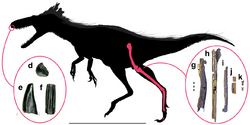Biology:Moros intrepidus
| Moros | |
|---|---|

| |
| Diagram showing known remains | |
| Scientific classification | |
| Domain: | Eukaryota |
| Kingdom: | Animalia |
| Phylum: | Chordata |
| Clade: | Dinosauria |
| Clade: | Saurischia |
| Clade: | Theropoda |
| Clade: | †Pantyrannosauria |
| Genus: | †Moros Zanno et al., 2019[1] |
| Species: | †M. intrepidus
|
| Binomial name | |
| †Moros intrepidus Zanno et al., 2019[1]
| |
Moros is a genus of small tyrannosauroid theropod dinosaur that lived during the Late Cretaceous period in what is now Utah. It contains a single species, M. intrepidus.[1] Moros represents one of the earliest known diagnostic tyrannosauroid material from North America.[1]
Discovery and naming
Moros was first discovered at the Stormy Theropod site located in Emery County in the U.S. state of Utah. Palaeontologists had been researching the area for ten years when, in 2013, limb bones were seen jutting out of a hillside, prompting the excavation.[2] The bones were described as of a new species in February, 2019.[3] The type species, Moros intrepidus, was named and described by Lindsay E. Zanno, Ryan T. Tucker, Aurore Canoville, Haviv M. Avrahami, Terry A. Gates, and Peter J. Makovicky. The generic name is derived from the Greek term Moros (an embodiment of impending doom), in reference to the establishment of the tyrannosauroid lineage in North America that would soon dominate the continent by the end of the Cretaceous. The specific name is the Latin word intrepidus ("intrepid"), referring to the hypothesized dispersal of tyrannosauroids from Asia throughout North America following the arrival of Moros.[1]
The holotype specimen, NCSM 33392, was found in the lower Mussentuchit Member of the Cedar Mountain Formation dating from the Cenomanian age. The layer has a maximimum age of 96.4 million years. The holotype consists of a right leg, specifically the thighbone, shinbone, second and fourth metatarsal, and the third and fourth phalanx of the fourth toe. Lines of arrested growth, or LAGs, indicate that it represents a subadult individual of six or seven years old, nearing its maximum size. Additionally, two premaxillary teeth were referred to the species, specimens NCSM 33393 and NCSM 33276.[1]
Description
Moros was a small-bodied, cursorial tyrannosauroid with an estimated leg length of 1.2 m (3.9 ft) and a body mass of 78 kg (172 lb).[1] The foot bones of Moros were extremely slender, with metatarsal proportions found to be more similar to ornithomimids than to other Late Cretaceous tyrannosauroids.[1]
Classification
In their 2019 phylogenetic analyses, Zanno and colleagues recovered Moros as a basal pantyrannosaurian alongside Asian taxa from the middle of the Cretaceous, such as Xiongguanlong and Timurlengia.[1] This phylogenetic affinity with Asian basal tyrannosauroids suggests that Moros was part of a transcontinental exchange between the biotas of Asia and North America during the mid-Cretaceous that is well-documented in other taxa.[1]
See also
References
- ↑ 1.0 1.1 1.2 1.3 1.4 1.5 1.6 1.7 1.8 1.9 Zanno, Lindsay E.; Tucker, Ryan T.; Canoville, Aurore; Avrahami, Haviv M.; Gates, Terry A.; Makovicky, Peter J. (February 2019). "Diminutive fleet-footed tyrannosauroid narrows the 70-million-year gap in the North American fossil record" (in en). Communications Biology 2 (1): 64. doi:10.1038/s42003-019-0308-7. ISSN 2399-3642. PMID 30820466.
- ↑ Johnson, Anna (February 21, 2019). "New dinosaur T. rex relative Moros intrepidus discovered". News Observer. https://www.newsobserver.com/news/local/article226512340.html.
- ↑ Greshko, Michael (February 21, 2019). "New tiny tyrannosaur helps show how T. rex got big". National Geographic. https://www.nationalgeographic.com/science/2019/02/new-tiny-t-rex-relative-moros-fills-north-american-fossil-gap/.
Wikidata ☰ Q61791935 entry
 |




